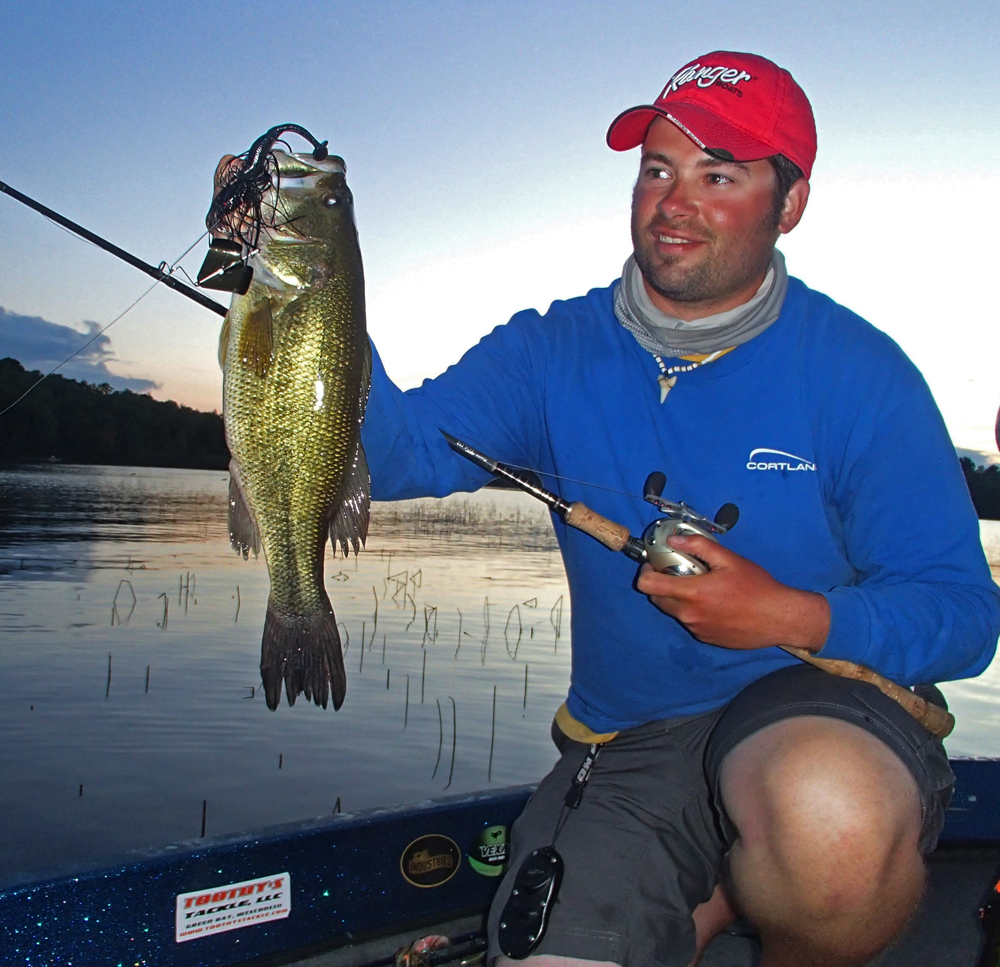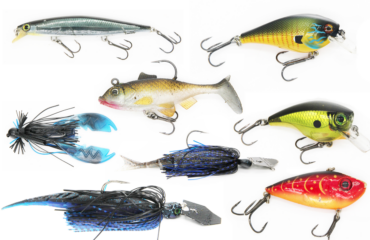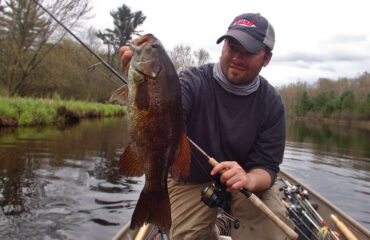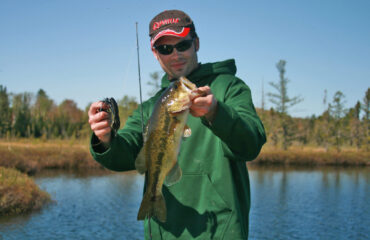Meteorology Bass
By Andrew Ragas
Meteorology is the study of atmospheric science, the calculated process in which scientists and weather experts forecast and predict future and incoming weather. Meteorology influences fishing every day and in every way, from all fish and underwater life to our own fishing activity. When preparing for a day’s fishing trip planning according to weather and conditions is the single most important factor for maximizing the best fishing opportunities at any body of water and for its fish species.
Fishermen are the best meteorologists. Every night before the next day’s trip, it’s probable that the smartest anglers will be on their Smartphone’s weather apps, or browsing on the internet researching and studying the next day weather forecast.
We don’t predict the weather, but we utilize forecasts to help make most of our fishing decisions, strategies, and lake selections on the projected conditions that will play into our favor. These conditions always include wind speed and direction, air temperature, sunlight exposure and light penetration, clouds and overcast skies, incoming weather fronts, humidity levels and dew points, sunrise & sunset, and lunar phase. Each is a major consideration in making calculated fishing decisions and strategies.
Not all anglers are fortunate to plan fishing trips according to weather. And not everyone has the luxury of being able to fish this way. But anglers who do so will usually experience the best fishing, and highest catch rates.
Bass Activity is Always a Product of the Weather
Winds from the west, fish bite the best. Winds from the east, fish bite the least. Winds from the north, do not go forth. Winds from the south blow bait in their mouth.
All weather conditions affect bass behavior and activity levels. Bass have acute senses about the weather. Their swim bladders and sensory organs drastically react to passing fronts and pressure changes. Fish display positive and negative reactions to changes in weather depending on its severity. For every weather pattern, bass will always display a positive or negative reaction in response to it.
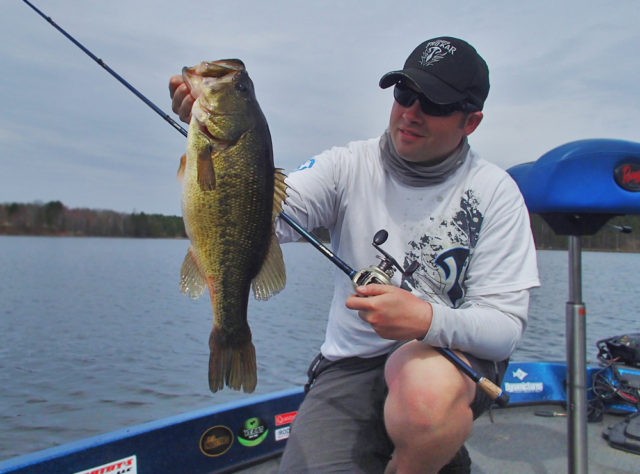
Weather is the single greatest influence to bass movements and feeding. Taking advantage of ideal conditions increases the odds for trophies.
All bass fisheries respond to weather and conditions in different ways. Some fisheries respond best to warm fronts, while others to cold fronts. Experience and time on the water will show you how. This reaction to weather depends on the layout and orientation of the lake, its composition, makeup and habitat, and how its resident fish species react to all weather patterns.
My lifelong fishing experience plays a major role in helping me determine how and where to fish. With thousands of lakes to fish in my region, I know where and when to fish them. When guiding clients, my lake selections for the next day’s fishing trip is always based on weather and understanding how that water and its bass fishery reacts and plays in the favor to the weather.
For instance, deep and clear lakes usually fish best on cloudy, overcast days. Lack of sunlight penetration causes fish to react and engage with more activity, blending clear transparent water clarity to the overcast atmosphere above. Meanwhile, shallow, weedy lakes with darker water clarity tends to fish best on sunny days, and might fare even better on cold front days as reduced light penetration and heavier weed cover will help comfort fish.
Certain bass fisheries respond best to warm fronts, or cold fronts too. A largemouth bass might react positively by seeking the thickest cover and feeding more aggressively in a cold front, while a smallmouth bass could go dormant and dwell the lake bottom until after a cold front passes. I offer some insights and personal experiences to how largemouth and smallmouth bass react to different weather systems during the seasons I fish.
Spring
The days grow longer by the minute, and the sun rises upward and higher to the northern skies. The climate warms due to a changing jet stream, channeling its southern and western winds northward. Runoff and snow melt seeps nutrients and new fertility into waterways, and the wet season delivers the highest rainfall totals and lake and river water levels of the year. As a result, underwater ecosystems awaken – re-starting the growth season, and spurring fish feeding sprees and spawning migrations.
Warming weather in spring drives all fish activity in spring. High pressure systems bringing sunlight and humidity regenerates weed growth and triggers the feeding of shallow water largemouth bass. Meanwhile sunny skies with warm southern winds that mixes with the lake’s cold water temperatures activates smallmouth bass, starting their spring spawning movements and influencing them to feed heavily on baitfish. This is why it’s always important to prioritize fishing the warmest areas of lakes.
Good weather and climate in spring positively influences bass fishing. Bad weather can negatively impact bass fishing too. Spring cold fronts with cold northwest winds delay all spring movements including the spawn, and bass retreat away from the shallows until water temps climb again. Spring cold fronts are so detrimental to fisheries that they can shut down feeding at most lakes unless the current within a river system or flowage helps minimize the impact and effects.
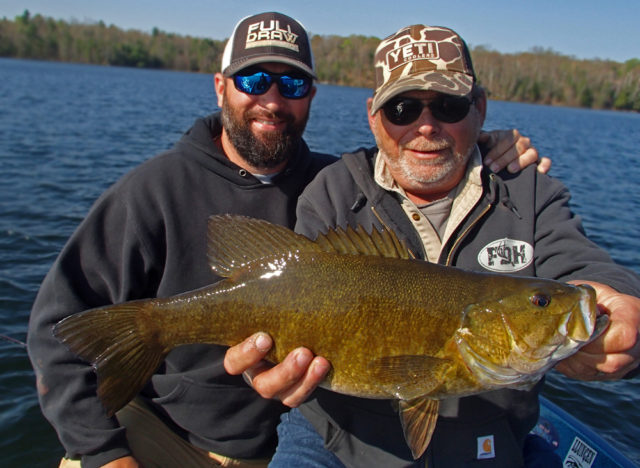
Ever notice how most of my trophy smallmouth photos from spring are on sunny days? Sunny skies with warm southern winds that mixes with the lake’s cold water temperatures activates smallmouth bass, starting their spring spawning movements and influencing them to feed heavily on baitfish. Jeff and Bubby Butler hold a 21 incher boated in May, 2018.
Summer
By now the weather is the best and most consistent it will be for an entire year. Summer heat produces algae blooms on the fertile drainage systems and heavier vegetated lakes, resulting in active and aggressive shallow water feeding among both bass species. Additionally, some lakes stratify with a thermocline, driving the biggest smallmouth deeper to take up residence in the coolest, comfortable to them, and most oxygenated depths of the lake.
Warm fronts, high humidity, calm surfaces, and heat waves drive the ecosystem, making fishing and patterning bass easy and predictable. Slight weather changes such as wind shifts, overcast skies, light rain, good moon phase and lunar tables (new moon and full moon), and dropping pressure temporarily makes fishing even better, triggering more feeding windows.
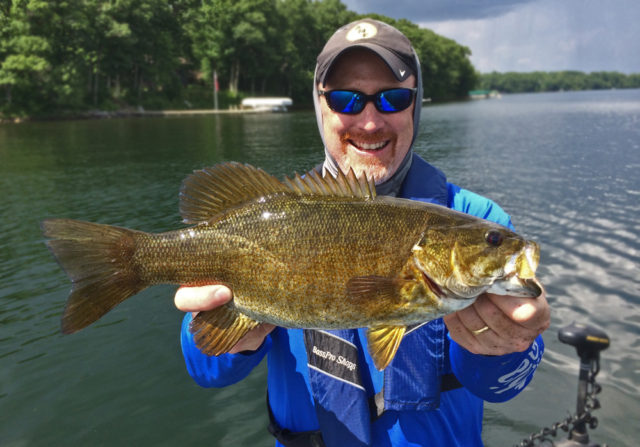
Warm fronts, high humidity, calm surfaces, and heat waves drive the ecosystem, making fishing and patterning bass easy and predictable. Slight weather changes such as wind shifts, overcast skies, light rain, good moon phase and lunar tables (new moon and full moon), and dropping pressure temporarily makes fishing even better, triggering more feeding windows. Michael Koch with one of several smallmouth we boated together in July, 2018. The day’s fishing grew better with passing fronts.
But all good things never last forever. Major weather systems such as powerful thunderstorms, the crackle of thunder and lighting, and cold fronts following high pressure can ruin all the good fishing one might have experienced hours before. Bass will hunker down and become skittish as a result, making them difficult to catch on even the slowest finesse or bottom oriented presentations. The morning of a cold front is the day you are better off sleeping in, or not fishing at all.
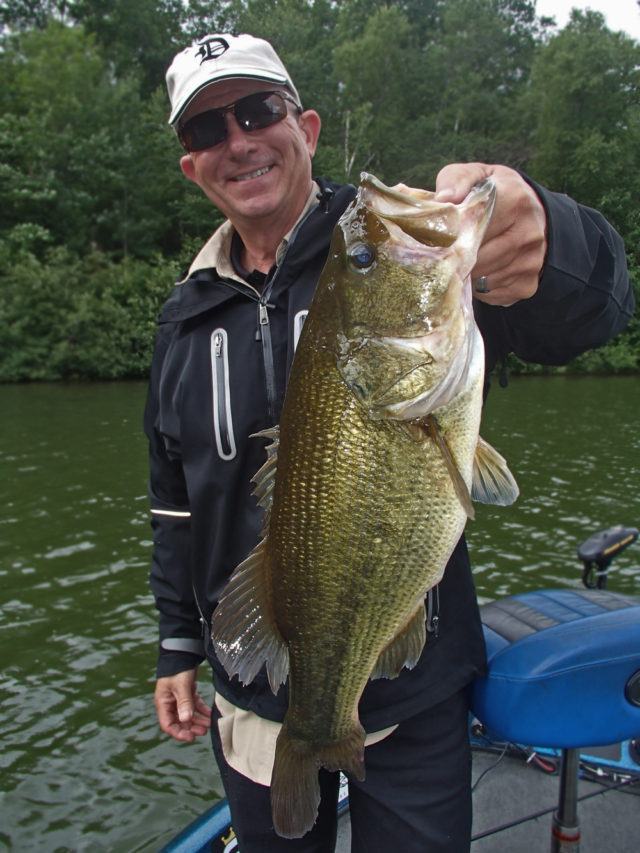
As a result of mid-summer cool downs, water temperatures cool, often sending many large smallmouth back towards the shallows and making them easier to catch. Sam Duell, with a 20 incher from July, 2018.
The weather ahead of cold fronts will often lead to favorable fishing conditions due to falling barometric pressure. Because of bass sensory organs, they will often increase their activity in the days before a cold front moves in. This activity can result in longer feeding windows, improved fishing and catch rates.
After the front passes through and for a few days after, conditions will remain poor. The high pressure that follows behind cold fronts contributes to lethargic fish that won’t move as far or as near the surface. The impact from cold fronts is most drastic and negative to smallmouth bass. This pressure change affects smallmouth swim bladders the most, and keeps them pinned down towards the bottom where they will not chase moving baits.
Mid summer cool downs bring many benefits. Bass may return to the shallows as a result of cooling water temperatures. Additionally, heavy feeding and fish activity returns.
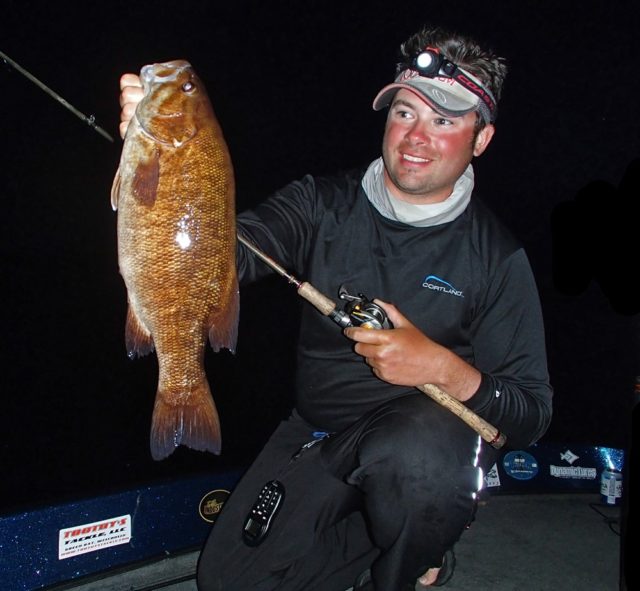
During the dog days of summer, smallmouth that are deep and difficult to find in midday often return to the shallows to feed at night. This time of season is when I prioritize and plan several trips for evenings and overnight hours in order to take advantage of a good bite that gets influenced by weather and conditions.
Fall
The days become shorter, and the sun falls lower into the southern skies. The climate cools due to a changing jet stream, channeling its north winds southward. The lower sun and reduced sunlight penetration delivers cold weather, which then cools water temperatures, influencing bass to undertake their annual wintering migrations into deep water.
Weather drives all fishing and seasonal phases. Without it, lakes won’t stratify during the summer time and turn over later in fall. Turnover is the focal point of fishing during the autumn season. Some lakes get it, while others do not. If your fall bass fishing doesn’t revolve around the phases of turnover, fishing will be more challenging.
Cold fronts and cool downs represent some of the best fishing and feeding phases of the fall season. The passing of each cold front until winter’s arrival becomes more severe. Bass sense that their growing season is coming to an end, and cold blasts and northwest winds trigger feeding spurts. In addition to cold fronts, rainfall and snow showers can also trigger fish into feeding. The cold water temperatures of autumn result in the slowest fish activity and metabolism, but increases feeding in order for bass to build up their energy reserves for winter.
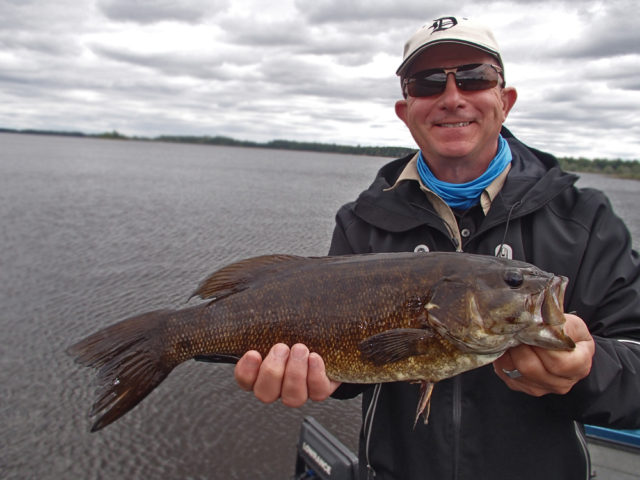
As a result of mid-summer cool downs, water temperatures cool, often sending many large smallmouth back towards the shallows and making them easier to catch. Sam Duell, with a 20 incher from July, 2018.
Be Your Own Weatherman
The study of weather and how it shapes fishing is fascinating and one that makes you think like a fish more. One of the most important aspects to the successful planning and execution of a fishing trip is scheduling during periods of best weather and anticipating how fish will respond positively and in favor of weather and conditions. If you aren’t studying the weather and forecast the night before a trip, and then basing your lake selections on it, you aren’t going to fish efficiently or successfully. Worse yet, you might end up fishing at the wrong body of water that day. During any weather system, you should always be at a body of water that fishes favorably to the weather and conditions you are being dealt with.
In today’s informational age, anglers are equipped with smart phones and applications, and access to computer and internet for all fishing research and planning. Data to help calculate the best fishing opportunities and use to our advantage to help us catch fish from all worldwide locations is available at ease, and in real time.
Utilizing tools and apps such as Weather Bug, Best Fishing, The Weather Channel, MyRadar, NOAA, USGS, Rivercast, and several more helps me with planning and preparation for an entire week’s trip throughout every season. From radar to other specific data, many of these applications are accurate and essential for projecting and anticipating the best fishing times for the week, and each day.
One of the major reasons why any fishing trip goes wrong is because of weather and how it went wrong and shut down the fishing. In far northern fishing destinations coldfronts are more severe and long-lasting, able to wreck an entire week’s worth of fishing during the spring and summer season. It happens, and unfortunately nothing can be done but making adjustments to counteract. Never make an uncalculated fishing decision and trip itinerary without consultation of a phone app or weather website first.
Weather conditions of all types affect fish behavior, feeding, and locations. From dreaded cold fronts and soaring barometric pressure to mid-summer heat waves, thunderstorms, or overcast skies, Mother Nature always plays a hand in our favorite pursuit and influences the activity levels of bass. Bass anglers who study weather forecasts and fish according to them are the best meteorologists and better anglers for it.
Andrew Ragas splits time between the Chicago area and Wisconsin’s Northwoods. Based in Minocqua, WI, he specializes in trophy bass fishing and offers guided trips from May thru October. While big bass is the passion, he dabbles in multi-species as well. He may be visited online at www.northwoodsbass.com


